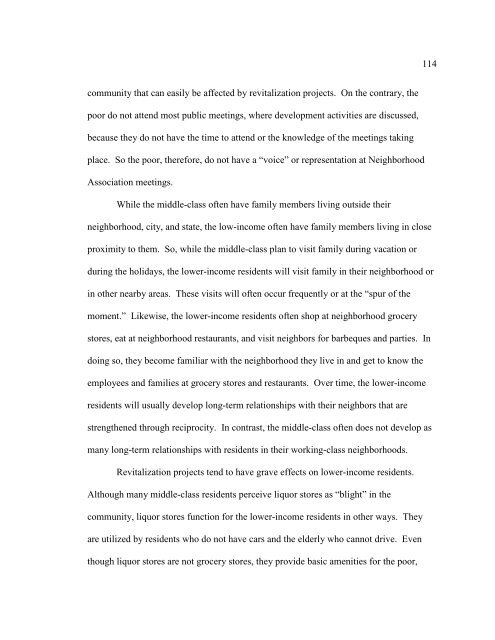COMMUNITY ACTIVISM IN OAK PARK: COMPETING AGENDAS ...
COMMUNITY ACTIVISM IN OAK PARK: COMPETING AGENDAS ...
COMMUNITY ACTIVISM IN OAK PARK: COMPETING AGENDAS ...
Create successful ePaper yourself
Turn your PDF publications into a flip-book with our unique Google optimized e-Paper software.
community that can easily be affected by revitalization projects. On the contrary, the<br />
poor do not attend most public meetings, where development activities are discussed,<br />
because they do not have the time to attend or the knowledge of the meetings taking<br />
place. So the poor, therefore, do not have a “voice” or representation at Neighborhood<br />
Association meetings.<br />
While the middle-class often have family members living outside their<br />
neighborhood, city, and state, the low-income often have family members living in close<br />
proximity to them. So, while the middle-class plan to visit family during vacation or<br />
during the holidays, the lower-income residents will visit family in their neighborhood or<br />
in other nearby areas. These visits will often occur frequently or at the “spur of the<br />
moment.” Likewise, the lower-income residents often shop at neighborhood grocery<br />
stores, eat at neighborhood restaurants, and visit neighbors for barbeques and parties. In<br />
doing so, they become familiar with the neighborhood they live in and get to know the<br />
employees and families at grocery stores and restaurants. Over time, the lower-income<br />
residents will usually develop long-term relationships with their neighbors that are<br />
strengthened through reciprocity. In contrast, the middle-class often does not develop as<br />
many long-term relationships with residents in their working-class neighborhoods.<br />
Revitalization projects tend to have grave effects on lower-income residents.<br />
Although many middle-class residents perceive liquor stores as “blight” in the<br />
community, liquor stores function for the lower-income residents in other ways. They<br />
are utilized by residents who do not have cars and the elderly who cannot drive. Even<br />
though liquor stores are not grocery stores, they provide basic amenities for the poor,<br />
114














![Completed Thesis to Grad Studies[Final3].pdf](https://img.yumpu.com/17538645/1/190x245/completed-thesis-to-grad-studiesfinal3pdf.jpg?quality=85)

